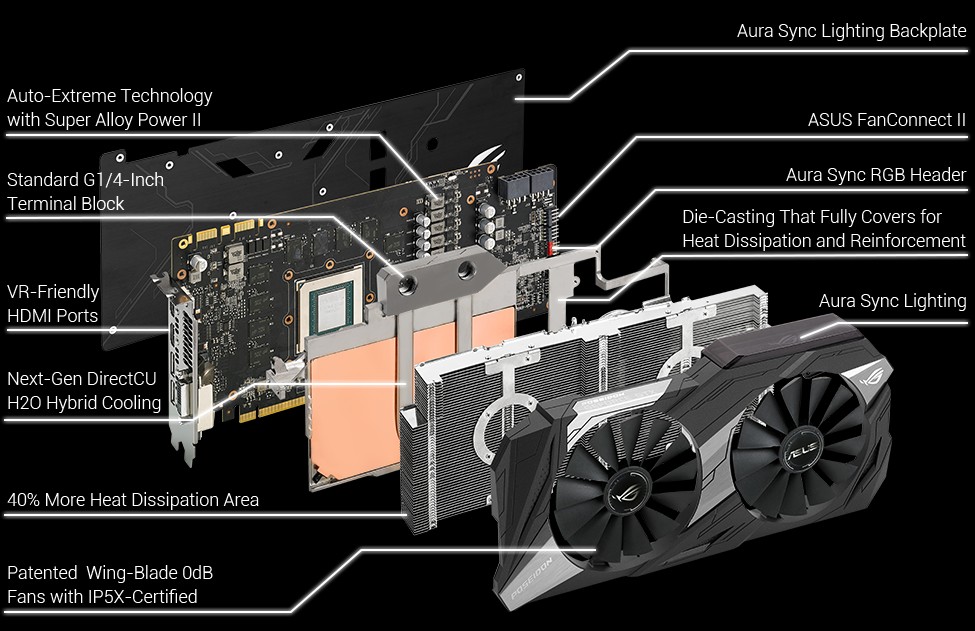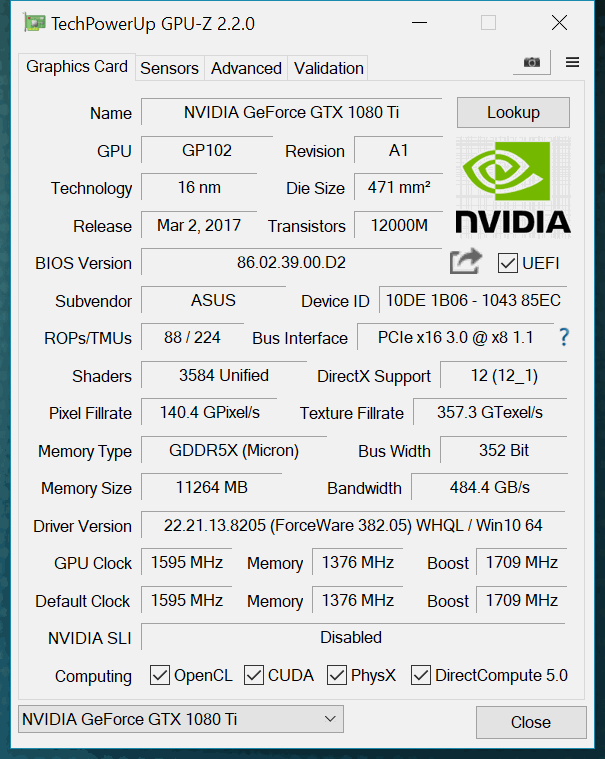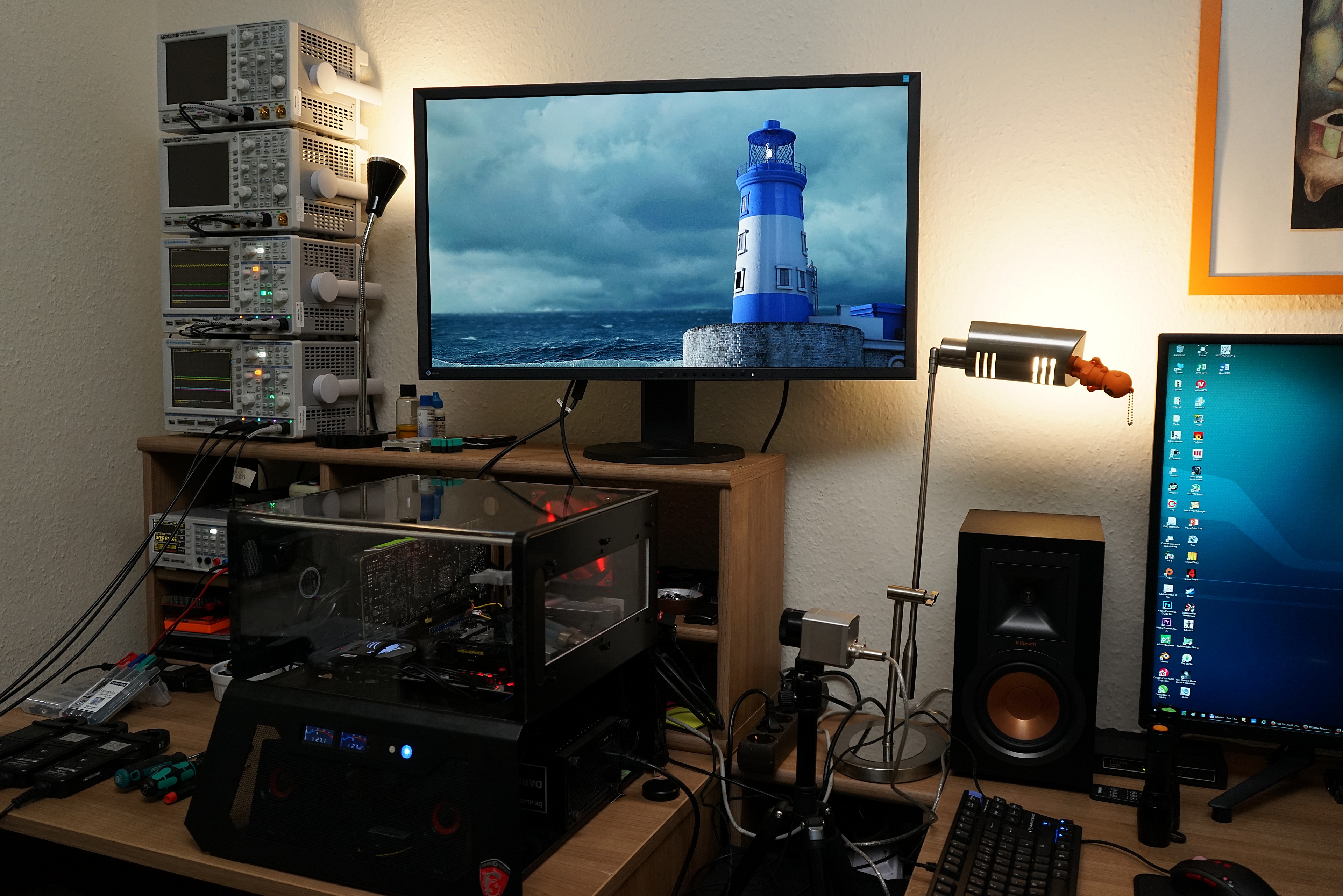Early Verdict
If you remain undecided about the cooling approach for your next gaming PC, and fear the loss of warranty coverage if you change your mind, Asus' ROG Poseidon gives you the best of both worlds (or at least, as good as they get without committing to one direction or the other). The card certainly isn't bad. It just appeals to a very specific customer.
Pros
- +
Aggressive factory overclock
- +
Flexible cooler
- +
Minimal whine from chokes
- +
External fan connectors
- +
RGB lighting
Cons
- -
Restricted liquid flow
- -
Relatively expensive card
- -
Low-frequency bearing noise
- -
Heat pipe quality could be better
Why you can trust Tom's Hardware
Features & Specifications
The concept is simple (at least on paper): lay down a flat heat pipe on a large sink and, as an option, send water through to dissipate thermal energy from a flagship-class GPU. By adding water-cooling, you can either complement a capable heat sink and fan solution or replace it entirely.
It's certainly possible that such a hybrid may work quite well. There's no denying that Asus designed its ROG Poseidon GeForce GTX 1080 Ti 11GB Platinum Edition for flexibility though, so its performance, especially when it comes to water-cooling, does have its limits.
Since the actual performance of any third-party card depends on the GPU Boost frequency it can sustain, and thus on cooling, power limits, and processor quality, any review that relies on bar charts is little more than a snapshot of a single specimen. That's why we're putting our emphasis on the actual implementation of each model. To that end, a lot of equipment goes into thoroughly documenting a graphics card's behaviors. If you'd like a peek at what goes into such an evaluation, check out our Nvidia GeForce GTX 1080 Ti 11GB Review. It makes for a good baseline on which Asus builds.
This card is massive; it makes a bold visual appearance based on both size and lighting. Just remember that the ROG Poseidon is a 2.5-slot card, meaning it'll occupy three expansion slots in your case.
Exterior
Asus does take care to make a good first impression. Still, the entire front cover is made of simple plastics. The only highlights are the RGB lighting effects on the top and back, along with visible bits of the cooler (including the water-cooling fittings).
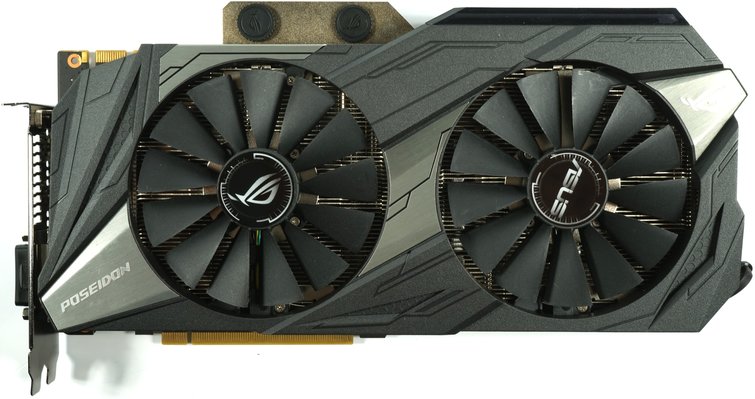
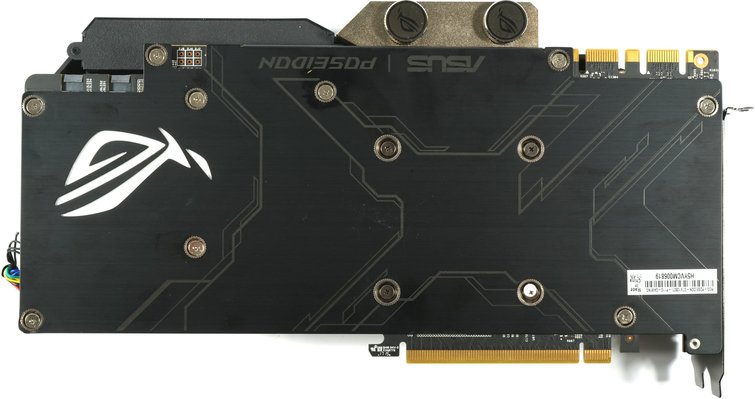
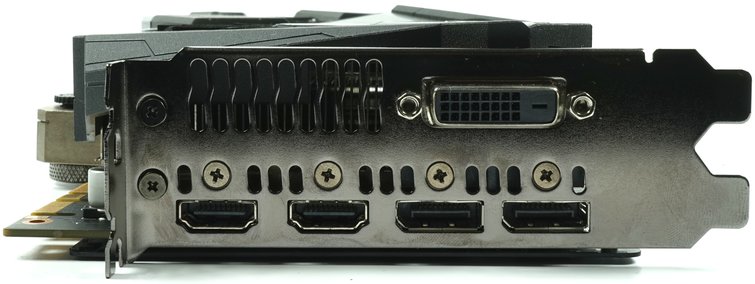
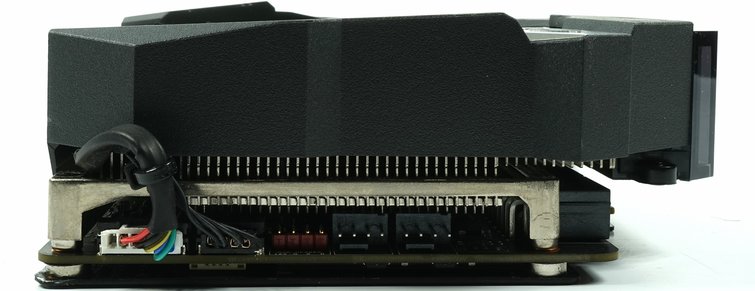
Specifications
A GPU-Z screenshot provides the most pertinent technical information, even if the GPU Boost values we observed were much higher than Asus' official specifications.
| Header Cell - Column 0 | NvidiaTitan X (Pascal) | NvidiaGeForce GTX 1080 Ti FE | AsusGTX 1080 Ti ROG Poseidon Platinum | NvidiaGeForce GTX 1080 FE | NvidiaGeForce GTX 980 Ti |
|---|---|---|---|---|---|
| GPU | GP102 | GP102 | GP102 | GP104 | GM200 |
| CUDA Cores | 3584 | 3584 | 3584 | 2560 | 2816 |
| Base Frequency | 1417 MHz | 1480 MHz | 1594 MHz | 1607 MHz | 1000 MHz |
| Boost Frequency | 1531 MHz+ | 1582 MHz+ | 1708 MHz | 1733 MHz+ | 1076 MHz+ |
| Memory Size & Type | 12GB GDDR5X | 11GB GDDR5X | 11GB GDDR5X | 8GB GDDR5X | 6GB GDDR5 |
| Die Size | 471 mm² | 471 mm² | 471 mm² | 314 mm² | 601 mm² |
| Process Technology | 16nm | 16nm | 16nm | 16nm | 28nm |
| Transistors | 12 billion | 12 billion | 12 billion | 7.2 billion | 8 billion |
| Streaming Multiprocessors (SM) | 28 | 28 | 28 | 20 | 22 |
| GFLOPS (Base Clock) | 10,157 | 10,609 | 11,426 | 8228 | 5632 |
| Texture Units | 224 | 224 | 224 | 160 | 176 |
| Texture Fill Rate | 317.4 GT/s | 331.5 GT/s | 357.1 GT/s | 257.1 GT/s | 214 GT/s |
| ROPs | 96 | 88 | 88 | 64 | 96 |
| Pixel Fill Rate | 136 GPix/s | 130.24 GPix/s | 140.3 GPix/s | 114,2 GPix/s | 116.7 GPix/s |
| Memory Data Rate | 10 Gb/s | 11 Gb/s | 11 Gb/s | 10 Gb/s | 7 Gb/s |
| Memory Bus | 384-bit | 352-bit | 352-bit | 256-bit | 384-bit |
| Memory Bandwidth | 480 GB/s | 484.4 GB/s | 484.4 GB/s | 320 GB/s | 336 GB/s |
| L2 Cache | 3 MB | 2816KB | 2816KB | 2MB | 3MB |
| TDP | 250W | 250W | 275W (PT) | 180W | 250W |
Test System
We explained our test system and methodology in How We Test Graphics Cards. If you want to learn more about the procedures we're using in today's review, have a look at that story. In the time since it was published, we also upgraded our CPU and cooling system to rule out any possible host processing bottlenecks.
Get Tom's Hardware's best news and in-depth reviews, straight to your inbox.
A short summary in table-form to provide a quick overview:
| Test System | |
|---|---|
| System | Intel Core i7-6900K @ 4.3 GHzMSI X99S XPower Gaming TitaniumCorsair Vengeance DDR4-32001x 1TB Toshiba OCZ RD400 (M.2, System SSD)2x 960GB Toshiba OCZ TR150 (Storage, Images)be quiet Dark Power Pro 11, 850W PSUWindows 10 Pro (All Updates) |
| Cooling | Alphacool Eisblock XPXAlphacool Eiszeit 2000 Chiller2x be quiet! Silent Wings 3 PWM (Closed Case Simulation)Thermal Grizzly Kryonaut (Used when Switching Coolers) |
| Case | Lian Li PC-T70 with Extension Kit and ModsConfigurations: Open Benchtable, Closed Case |
| Monitor | Eizo EV3237-BK |
| Power Intake | Contact-free DC Measurement at PCIe Slot (Using a Riser Card)Contact-free DC Measurement at External Auxiliary Power Supply CableDirect Voltage Measurement at Power Supply2x Rohde & Schwarz HMO 3054, 500MHz Digital Multi-Channel Oscilloscope with Storage Function4x Rohde & Schwarz HZO50 Current Probe (1mA - 30A, 100kHz, DC)4x Rohde & Schwarz HZ355 (10:1 Probes, 500MHz)1x Rohde & Schwarz HMC 8012 Digital Multimeter with Storage Function |
| Thermography | 1x Optris PI640 80Hz Infrared Camera + PI ConnectReal-Time Infrared Monitoring and Recording |
| Acoustics | NTI Audio M2211 (with Calibration File, Low Cut at 50Hz)Steinberg UR12 (with Phantom Power for Microphones)Creative X7, Smaart v.7Custom-Made Proprietary Measurement Chamber, 3.5 x 1.8 x 2.2m (L x D x H)Perpendicular to Center of Noise Source(s), Measurement Distance of 50cmNoise Level in dB(A) (Slow), Real-time Frequency Analyzer (RTA)Graphical Frequency Spectrum of Noise |
MORE: Best Graphics Cards
MORE: Desktop GPU Performance Hierarchy Table
MORE: All Graphics Content

Igor Wallossek wrote a wide variety of hardware articles for Tom's Hardware, with a strong focus on technical analysis and in-depth reviews. His contributions have spanned a broad spectrum of PC components, including GPUs, CPUs, workstations, and PC builds. His insightful articles provide readers with detailed knowledge to make informed decisions in the ever-evolving tech landscape
-
Pat Flynn I wonder how their cooler compares to something like EKWB's blocks? Temps/overclock wise that is.Reply -
dan88rx7turbo I have the Poseidon , sits at about 43c on load in Valley and Superposition 4k , 1080p extreme settings!Reply -
JackNaylorPE 1. The Poseidon is a great idea in concept but suffers from poor implementation.Reply
2. The addition of the PCB parts is a welcome addition. However w/o an explanation of how they differ from reference cards or compare to other AIB cards, it inda falls flat.
3. Benchmark Comparisons w/ just the reference model again leaves me wanting more. Asus Strix would at least allow comparisons to other AIB cards
.
4. And yes .... would have been very useful to compare against other options. An EVGA Hybrid and say the MSI Seahawk EK X (w/ full cover EK water block) would also be a big plus.
-
drmacaron i also have a poseidon. Super good temp dont know why the warer development aded maby if you should clocke it bigtime ?Reply -
mac_angel I have the Asus Strix 1080ti OC. It 'boosts' to 2Ghz on it's own. But playing with the curve in Afterburner, I get 2076MHz, on air. That's without flashing the ROMReply -
JackNaylorPE Reply20192947 said:I have the Asus Strix 1080ti OC. It 'boosts' to 2Ghz on it's own. But playing with the curve in Afterburner, I get 2076MHz, on air. That's without flashing the ROM
The OC is be expected ... from the article :
With sufficient water cooling, however, we were able to reach 2076 MHz. That's where our chip hit its ceiling, even after installing a high-end loop, increasing the power target, and applying a bit of extra voltage.
But outta the box, the boost is down at 1708 / 1709
http://www.tomshardware.com/reviews/asus-rog-poseidon-gtx-1080-ti-platinum,5151.html
-
Rheotome Both of these statements are incorrect:Reply
"lay down a flat heat pipe on a large sink and, as an option, send water through to dissipate thermal energy"
"The thermal solution utilizes a copper sink that doubles as a block for water cooling (by guiding liquid through the hollow heat pipe). "
No water flows through a heat pipe. A heat pipe is hollow, closed and sealed to contain the working fluid that evaporates and condenses to transfer heat from a hot to cold point.
The author is confusing heat exchanger and heat pipe technology. -
JackNaylorPE Actually, no ... there is no air involved in a heat exhangerReply
"A heat exchanger is a device used to transfer heat between a solid object and a fluid, or between two or more fluids."
The proper term here would simply "radiator tube" under normal circumstances ... as it is employed here, it's simply part of a hybrid water block, heat sink / radiator.

